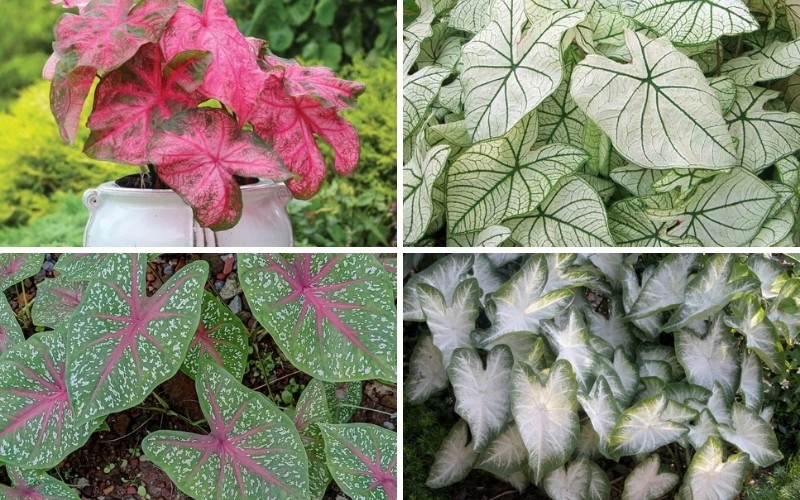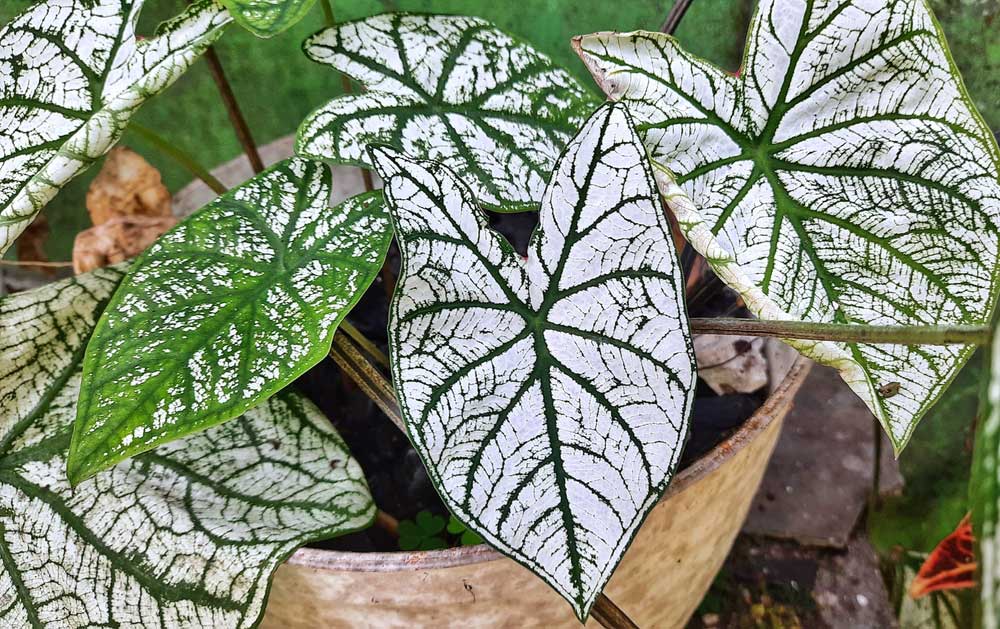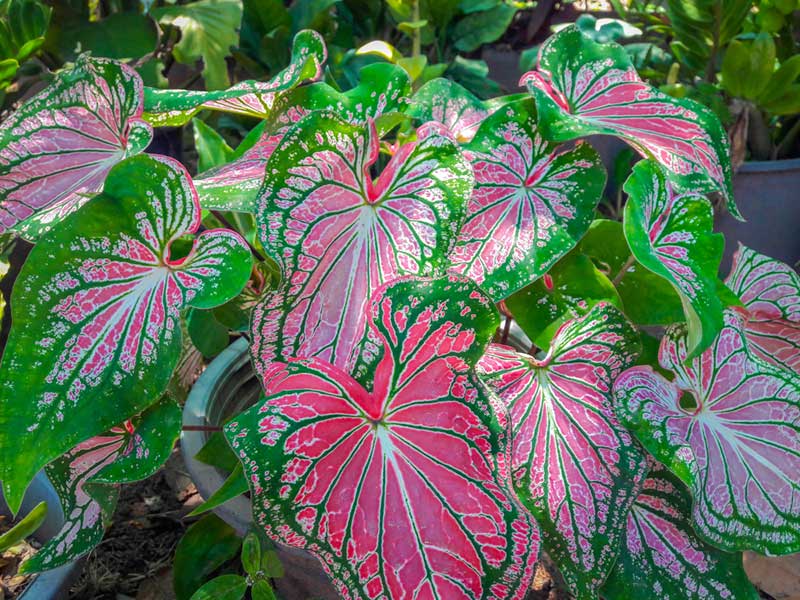
Caladium is prized for its striking foliage. Arrow-shaped leaves range in color from dazzling white to variegated shades of red, pink and green, depending on the variety.
These tropical perennials thrive in shady or partially shaded areas in USDA plant hardiness zones 9 and 10.
In cooler climates, caladium can be grown as annuals providing a showy display of color all summer long. Caladiums require relatively little care making them ideal for tucking into shady or partially shady areas in your yard.
Caladium Plant Care Guide
Light Requirements
Caladium thrives in shady to partially shady locations in southern locations but can tolerate more sun in northern regions. Direct morning and afternoon sun will produce the most vibrant color in caladium foliage, but even in northern climates they benefit from some shelter from direct noonday sun.
Some varieties, such as ‘Carolyn Whorton’, ‘Postman Joyner’ and ‘White Queen’ are sun tolerant. Check the sun requirements of your specific variety when choosing a location for planting your caladiums.
Watering
Caladiums prefer evenly moist soil that drains well. In a typical garden this means 1 to 2 inches of rainfall per week is adequate for caladiums, but beware. Caladiums grown in full sun or in containers require more frequent watering.
If you are unsure if your caladiums are getting enough water, check the soil 1-inch below the surface. If it is dry, it is time to water your caladiums.
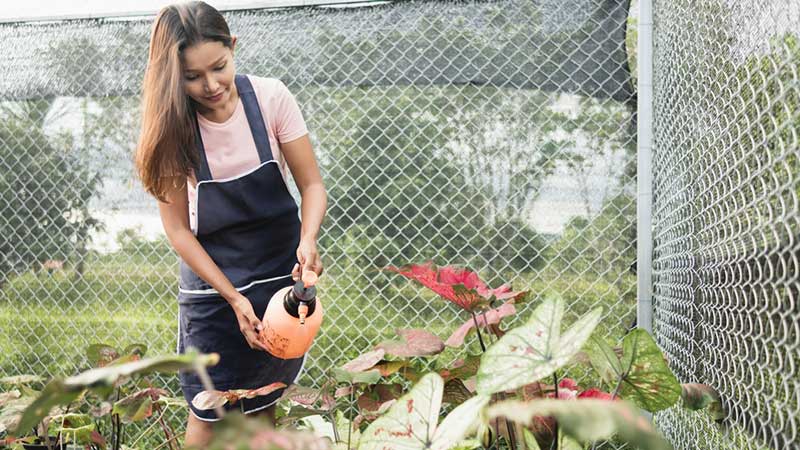
Soil
Caladiums prefer humus-rich well-drained soil that is slightly acidic. A pH between 5.5 and 6.2 is ideal. Adding a 2-to-3-inch layer of peat moss to the soil and working it into the existing soil will help to lower the pH and create slightly acidic soil. If you are unsure of the pH of your soil, you can buy an inexpensive soil test kit at the hardware store to take a quick test.
Fertilizer
Caladiums benefit from an application of bone meal when planted and can be fertilized with water-soluble fertilizer every 10 to 14 days throughout the summer, if needed.
Use the health of your caladium plants as a guide when applying supplemental fertilizer.
Deadheading & Pruning
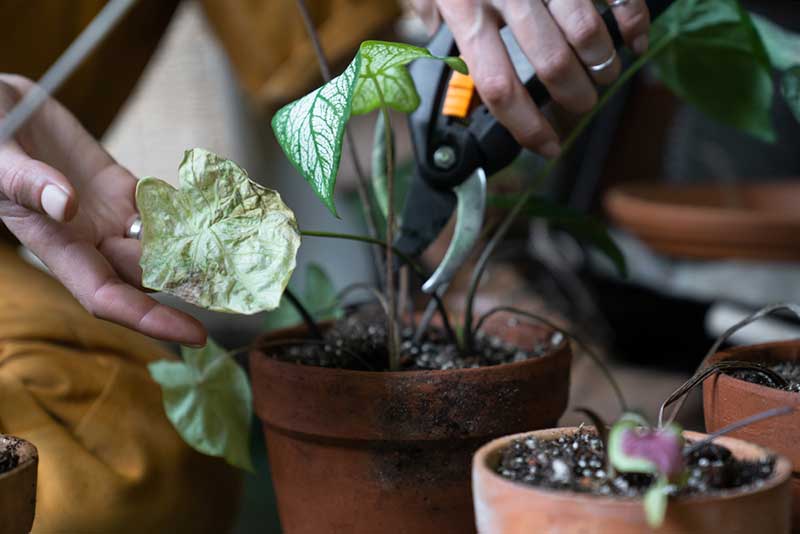
Caladium is grown for its attractive foliage, but sometimes it produces blooms on a tall stalk, too. Most consider the blooms unattractive and remove the stalk by cutting it at the base when it appears to force energy into leaf growth. Flowers can be left to bloom if you prefer.
Otherwise, removing any dead or shriveled foliage that appears is all the deadheading and pruning a caladium needs.
How to Plant Caladium Bulbs?
Caladium bulbs require warm soil to sprout and grow. Temperatures below 65 degrees may damage the bulbs and prevent them from growing. That means those in northern climates should start the bulbs inside 4 to 8 weeks before planting them outside or wait until mid-June when the soil is warm enough for planting.
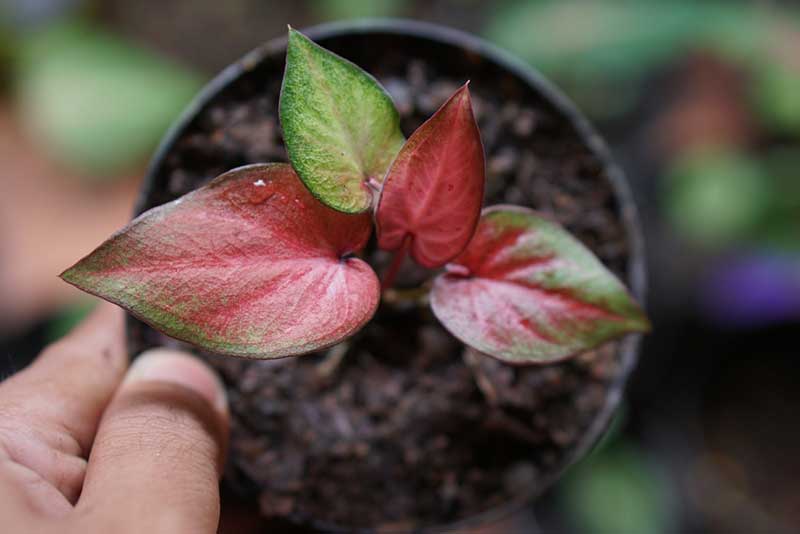
- To start them inside, fill individual pots with potting mix and plant the bulb with the flattened side down and the bumpy side up. The bumps on the bulb are the eyes or growing points where new shoots will appear. Cover them with 1 ½-inches of soil and keep the soil moist, but not soggy, until new shoots appear. Place the pots in an area that receive bright filtered light.
- To plant caladium bulbs outside, prepare the soil in a partially sunny location by tilling it to a depth of 8-inches. Apply a light application of bone meal and mix it into the soil. Place the bulbs in the soil spaced 4 to 6 inches apart and cover them with 1 ½ to 2 inches of soil, depending on the size of the bulb. As a rule, flower bulbs should be planted to a depth three times the size of the bulb. Firm down the soil to remove air pockets and water the area thoroughly. Keep the soil moist, but not soggy, until new shoots appear.
Lifting and Storing Caladium Bulbs
Caladium grown in USDA plant hardiness zones 9 and 10 will survive the winter without lifting the bulbs. In cooler climates, the bulbs must be dug and stored for the following year.
Dig up the bulbs when temperatures drop into the 60s and allow them to dry for a few days. Remove and dead foliage and shake off the old soil. Place the bulbs in a bag or box of peat moss, sawdust or vermiculite and store them in a dry area where temperatures remain above 60 degrees.
Caladiums die back in the fall and go dormant for the winter.
Even those grown as houseplants will lose their leaves when it is time. Keep the soil slightly moist to prevent the bulbs from drying out completely during the winter and new growth will appear in the spring.





